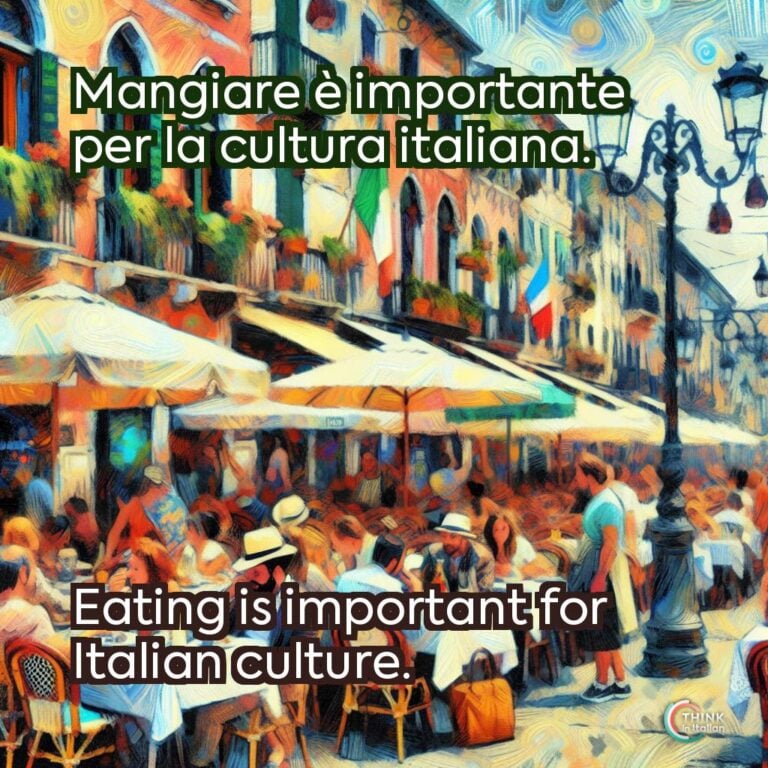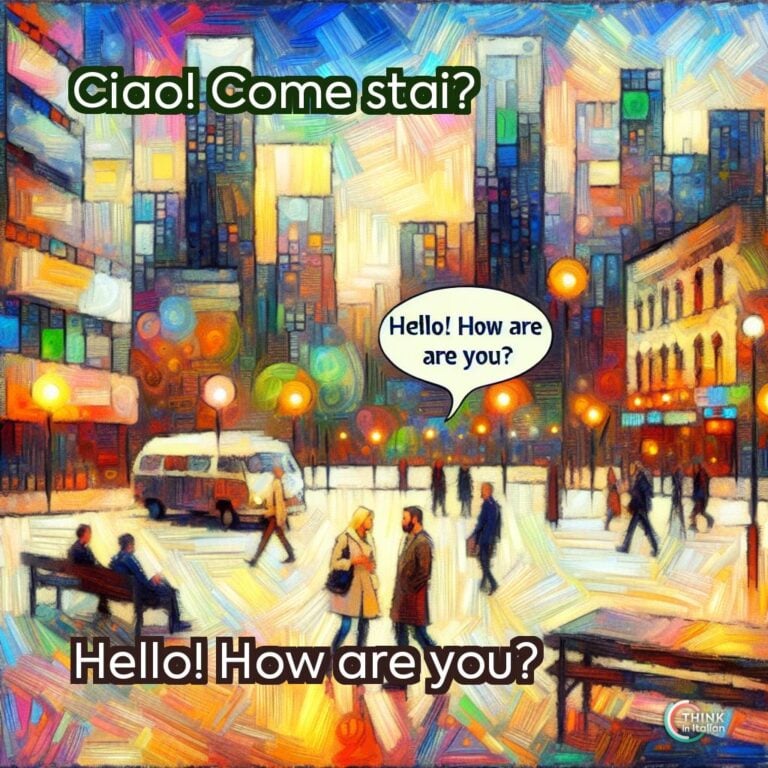What is the Most Popular Italian Word?
Establishing which is the most popular Italian word is not easy. It depends on what criteria we choose to run these statistics.
When scrolling lists of common words online we find definite and indefinite articles at the top of most of them. They are undoubtedly very commonly used, but they lack content.
Before we dive into the most common Italian words, let me make a clear distinction between content word and function words.
Content words are words with semantic value: they mean something (like verbs, nouns, and adjectives). Function words, instead, are only rich in grammatical features (like articles, conjugations, and prepositions).
Therefore, when you read those confusing lists of random Italian words numbered from 1 to 1000 you are not really grasping how commonly those words are used.
To give you an idea, read about the top three most common Italian content words below. Then, I will also provide you with an exhaustive table of the 50+ most used ones!
Cosa: a Versatile Placeholder
When delving into Italian, you can quickly encounter the word cosa, a noun that tops the list of the 1000 most used Italian words. It is widely used, demonstrating the rich contextuality of the language. For example:
- Questa è la cosa più bella che io abbia mai visto. (This is the most beautiful thing I have ever seen), where “cosa” simply means “thing“.
- Cosa mangiamo stasera? (What do we eat tonight?), where “cosa” implies food based on conversational context.
- Ti ricordi quella cosa che abbiamo visto? (Do you remember that thing we saw?) where “cosa” is used as a placeholder for an unnamed object.
This versatility explains why “cosa” is so prevalent in everyday Italian speech.
Ciao: A Cultural Icon
Another pervasive word is “ciao,” meaning hello, commonly used in informal settings. When I discovered its story and evolution I was really fascinated!
Ciao comes from the Venetian dialect, spoken in the Northeast of Italy. Back in the 17th century, servants used the expression “s-ciào vostro” (I am your slave) to address and greet their superiors.
Over time, “s-ciào vostro” was shortened to simply “s-ciào” and finally to “ciào”. The word has then lost its servile connotations to become a standard informal greeting, replacing more formal ones in many everyday contexts.
“Ciao” is surely one of the words I use the most daily, because unlike other languages, it can be used both when you arrive somewhere and when you leave the place.
Mangiare: The Verb of Italian Cuisine
Understanding “mangiare,” the verb for eating, is essential given Italy’s renowned culinary culture.
Following the typical -are conjugation pattern, this verb is central to discussing food. Interestingly, specific verbs like pranzare and cenare are used for eating lunch and dinner respectively, showing the language’s culinary specificity.
Mangiare is probably the most important Italian verb you need to know if you’re planning to go to Italy!
50+ Most Common Italian Words
Here you can find the 50+ most common Italian words. As I wrote before, these are the words that most commonly appear in Italian texts and conversations.
As you might notice at first glance, many of these terms are functional words that appear in language because of their very important function, indeed.
| Italian | English |
| sono | am |
| io | I |
| il | the |
| che | that |
| lui | he |
| per | for |
| come | as/like |
| con | with |
| loro | they |
| essere | to be |
| uno | one |
| avere | to have |
| questo | this |
| da | from |
| di | of |
| caldo | hot |
| parola | word |
| ma | but |
| cosa | what |
| alcuni | some |
| è | is |
| quello | that |
| tu | you |
| o | or |
| suo | his/her |
| una | a |
| io | I |
| fare | to do/make |
| tempo | time |
| se | if |
| come | how |
| detto | said |
| ogni | each |
| dire | tell |
| fare | does |
| tre | three |
| bene | well |
| anche | also |
| giocare | play |
| piccolo | small |
| casa | home |
| leggere | read |
| mano | hand |
| grande | large |
| qui | here |
| alto | high/tall |
| seguire | follow |
| perché | why |
| chiedere | ask |
| uomo | man |
| mondo | world |
| vicino | near |
| costruire | build |
| vedere | see |
| due | two |
| buono | good |
| dare | give |
| nostro | our |
| sotto | under |
| nome | name |
I am sure you will see or hear these words very often. It is indubitably useful for Italian language learners to recognize them and be able to familiarize with them.
Now you only need to remember them, and let me explain to you how!
How Can I Enrich my Vocabulary?
Are you reading this article because you want to improve your Italian vocabulary? Then this is the right place to be.
Knowing what the most common Italian words are might be very useful to quantitatively improve your vocabulary skills.
Keep in mind that, as I said at the beginning, not all lists of words give you a truthful picture of what is commonly used when speaking.
Here are some tips that I find very useful when I want to learn new vocabulary in new languages. Try them with Italian and let me know if they worked for you!
The 80/20 Principle
The 80/20 principle, also known as the Pareto Principle, is a widely recognized efficiency model. It suggests that 80% of outcomes result from 20% of causes.
Do you want to know a fun coincidence? Pareto was an Italian economist!
In the context of vocabulary acquisition, this principle is applied by identifying and focusing on the 20% of the Italian vocabulary that is used in 80% of daily conversations and interactions.
This approach emphasizes quality over quantity, encouraging learners to prioritize words and phrases that will be most useful in practical scenarios. By doing so, learners can make the most efficient use of their study time.
This method is particularly beneficial for beginners who want to quickly achieve conversational fluency without being overwhelmed by the vastness of the Italian language.
To be honest, I had never tried this approach before, until I read about it and wrote it here. I am finding it very useful, so if I were you, I would give it a try!
Learn Words in Context
Apps such as Anki, Memrise, and Quizlet focus on traditional single-word flashcard study. They provide you with a set of flashcards with the basic Italian word on one side and the English translation on the other side.
In contrast, well-designed language courses focus on studying vocabulary in context by prompting the user to fill in the missing word in a sentence or repeating whole sentences.
With context-based flashcards, you’ll learn the meaning of the word, the appropriate situations to use it, and you’ll also have the chance to learn related vocabulary at the same time.
This way you will develop skills and strategies to more easily determine the meaning of unfamiliar words.
Real-Life Usage
Whenever you learn new words, it is crucial to put them into practice. Not only does this help with word retention, but also with words functional use.
Knowing how to order in a restaurant or ask for directions involves practical application of common phrases and vocabulary. I know it is hard to try it at the beginning, but I really encourage you to use Italian as much as possible!
However, if you do not live in an Italian-speaking context or do not know Italian people to practice with, you can make use of modern technology.
AI-driven tools offer personalized learning experiences, adapting to individual proficiency levels for a more effective learning journey.
I also find audio-lessons very useful for this purpose. By relying on speech and mimicking, you will learn Italian very fast, just like you did when you learned your first language when you were born.
Are you Ready to Learn the Most Common Italian Words?
Now you know everything you need to start learning the most used Italian words. And no, time is not an excuse!
You can learn Italian in the car, while showering, or while cooking! You just need motivation and a space where you can listen and repeat.
The best way you can do so is with the audio course “Ripeti con me”. Not only will this course help you learn new words and expressions, but also their pronunciation.
Let me know in the comment how many new words you learned!






